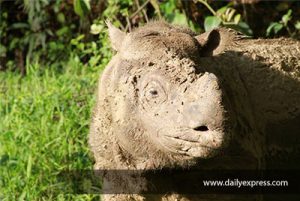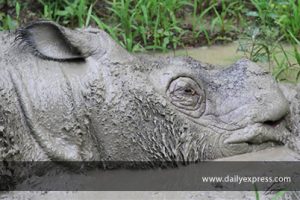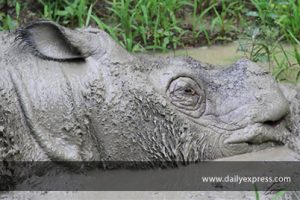 | ||||||||||||||||||||||
World Rhino Day is celebrated on 22nd September and celebrates all 5 species of the Rhino. It was first announced by WWF-South Africa in 2010 where it expanded over the coming years encompassing both African and Asian rhinos. World Rhino day has grown to be a global phenomenon, uniting NGOs, zoos and wildlife parks and other related organisation and business corporations. Rhinoceros, also known as rhino, is a group of five species of odd-toed ungulates from the family Rhinocerotidae. Two of these species are native to Africa which is the Black Rhino (Diceros bicornis) and the White Rhino (Ceratotherium simum) while the three species native to Southern Asia are the Great One Horned Rhino, also known as Indian Rhino (Rhinoceros unicornis) which is native to India and Nepal, the Javan Rhino (Rhinoceros sondaicus) found in Java Island, Indonesia and Vietnam, the Sumatran Rhino (Dicerorhinus sumatrensis) which is native in Sumatera Island Indonesia, Southern China – Bhutan, Cambodia and Borneo Island. | ||||||||||||||||||||||
The Sumatran Rhino (Dicerorhinus sumatrensis) The Sumatran Rhinoceros has been in existence longer than any other living mammal and is considered “primitive”. It is also known as the Hairy Rhino as it is the hairiest of all species especially on the ears and tail. When comes to the size, it is by far the smallest species of rhino. | ||||||||||||||||||||||
| ||||||||||||||||||||||
| ||||||||||||||||||||||
The Sumatran rhino is one of the most endangered animal species anywhere in the world. Due to hunting for its horn and forest loss over the past millennium, its population has decreased to a few remnant individuals. It is believed that fewer than 10 of the Bornean subspecies of rhino survive in small and highly fragmented populations in eastern and central Sabah, with similarly low numbers in Kalimantan, Indonesia. With such low numbers, the threats to the species now include the low probability of fertile females and males meeting in the wild, inbreeding and aging without reproducing. Yet the small remaining populations represent the only hope for the survival of this species. Borneo Rhino Alliance (BORA) helps to support and unite the combined efforts of government agencies, the industry, conservation NGOs, and the international rhino conservation network to ensure that remaining rhinos are secured within protected areas. | ||||||||||||||||||||||
Conservation of Sumatran Rhino Many action plans has been initiated by the government and also various industries including the Palm Oil Industry. One significant initiative from the palm oil industry is the Malaysian Palm Oil Wildlife Conservation Fund (MPOWCF) which was established in 2006 with initial fund of RM 10 Million while the balance fund of RM 10 million was provided by the palm oil industry, in which the fund is managed by Malaysian Palm Oil Council (MPOC). MPOC has the overall responsibility to manage the various conservation projects funded through MPOWCF. Through MPOWCF many conferences and seminars has been held to showcase the conservation efforts by the industry and also to portray the current status of wildlife and biodiversity conservation undertaken by many stakeholders. | ||||||||||||||||||||||
Rhino Action Plan During Sabah Wildlife Conservation Colloquim (SWCC) on January 2012, a three five-year State Species Action Plan for the Orang-utan, Elephant and Rhinoceros were launched to provide a platform for better protection of the three flagship species. The plans are part of the nation and state’s continued commitment towards conservation and continuation of its unique flora and fauna. The State Species Action Plan is designed for the three main species; which are Orangutan (Pongo pygmaeus morio), Bornean Elephant (Elephas maximus borneensis) and Sumatran Rhinoceros (Dicerorhinus sumatrensis harrissoni). Each action plan is designed comprehensively for immediate, practical and adaptive conservation actions in order to ensure the long term survival of the species. The five year goal of the species action plan are to identify, develop and implement strategies and actions that will address the threats to the species in all priority populations identified in the State by providing guidance to key players that will implement these strategies. The plan was developed by Sabah Wildlife Department (SWD), HUTAN-Kinabatangan Orang-utan Conservation Project, Borneo Rhino Alliance (BORA) and Danau Girang Field Centre (DGFC). The Malaysian Palm Oil Council and the Malaysian palm oil industry is playing their role diligently for the success of this action plans through many collaborations and conservation efforts. | ||||||||||||||||||||||
Wildlife Rescue Unit (WRU)
| ||||||||||||||||||||||
Malua Wildlife Habitat Conservation Bank (MWHCB) Malua Wildlife Habitat Conservation Bank (MWHCB) was established after several wildlife census and expeditions revealed, that Malua Forest Reserve provides habitat for breeding populations of 16 IUCN red listed mammals and birds species including Orangutan, Borneon pygmy elephants, Sumatran rhinoceros, Borneon banteng and other iconic species. The Malua Partnership Wildlife Conservation Agreement was established to create a conservation partnership between the public sector and the oil palm plantations around Malua Forest Reserve, based on a common vision of nurturing a symbiotic relationship with the environment. The agreement was based on key research outcomes from studies funded by MPOWCF in 2013. Activities and programs during World Rhino Day concentrate in creating awareness among the general public and business corporations and calls for more funding and contribution for the protection and conservation of rhinos. Such events reminds us on the effort and role of many leaders and also Each and every efforts and gesture brought by every individual, organisation or corporations pushes the species away from the brink of extinction and gives hope for a better future for the Rhinos and mankind. | ||||||||||||||||||||||
MENUMENU
- About Palm Oil
-
-
-
About Palm Oil
Palm oil is derived from the flesh of the fruit of the oil palm species E.
Guineensis. In its virgin form, the oil is bright orange…
-
-
Palm Oil Plantation
-
Palm Oil Industry
-
FAQs
-
-
- Media & Resources Center
-
-
-
Media and Resource Center
Gain access our Media Center, MPOC Reposts and Resource Center.
-
-
Media Center
-
MPOC
-
Resources Center
-
-
- MPOC
-
-
-
MPOC
Malaysian Palm Oil Wildlife Conservation Fund (MPOWCF)
Leading the way in conservation opportunities and efforts
-
-
Corporate Profile
To promote the market expansion of Malaysian plam oil and its products by enhancing the image of palm oil and…
-
Regional Offices
HQ Office
Level 25, PJX HM Shah Tower,
No. 16A Jalan Persiaran Barat PJS 52,
46200 Petaling Jaya,
Selangor Darul Ehsan,
MALAYSIA
-
Palm Oil Links
-
-
- Market Statistics
-
-
-
-
Monthly Palm Oil Trade Statistics
-
Daily Palm Oil Prices
-
-
- Events
-
-
-
Events
-
-
-
-
- News



 Under the Malaysian Palm Oil Wildlife Conservation Fund (MPOWCF) and collaboration with SWD and Shangri-La Rasa Ria Resort, funds were allocated for the establishment and operation of Wildlife Rescue Unit (WRU). With highly trained rangers and wildlife personnel, WRU were involved in capturing and translocating rhinos to a better wildlife sanctuary for protection and conservation. The unit has successfully trapped and translocated a female Sumatran rhino named “Puntong” to the Borneo Rhino Sanctuary (BRS) in Tabin as a prospective suitor for “Tam”, a male Sumatran rhino in the effort to achieve breeding of the species. Till recently, another solitary Sumatran rhino, “Iman” was found in Danum Valley and translocated to the same facility for better monitoring and conservation efforts.
Under the Malaysian Palm Oil Wildlife Conservation Fund (MPOWCF) and collaboration with SWD and Shangri-La Rasa Ria Resort, funds were allocated for the establishment and operation of Wildlife Rescue Unit (WRU). With highly trained rangers and wildlife personnel, WRU were involved in capturing and translocating rhinos to a better wildlife sanctuary for protection and conservation. The unit has successfully trapped and translocated a female Sumatran rhino named “Puntong” to the Borneo Rhino Sanctuary (BRS) in Tabin as a prospective suitor for “Tam”, a male Sumatran rhino in the effort to achieve breeding of the species. Till recently, another solitary Sumatran rhino, “Iman” was found in Danum Valley and translocated to the same facility for better monitoring and conservation efforts. 